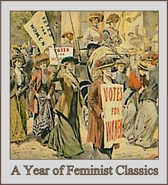Reviewed by Ingrid
Published: 2010
It's about: Bill Bryson explores all the questions you've always been curious about - why are there four tines on a fork, not three or five? Why are salt and pepper our staple table spices and not something else? What's the deal with petticoats? Each chapter is named after a different room in the house, each providing the opportunity to discuss different topics - for example, the history of hygiene in the "Bathroom" chapter, the history of fashion and corsets in the "Dressing Room" chapter, a discussion of rats in the "Study" chapter.
I thought: I'm happy to report that I've finally read one of the books from my Top Ten Books I'm Dying to Read list from last September. As it turns out, this book was packed with interesting information and was also delightfully accessible, a welcome change from the scholarly articles and books that required heavy concentration that I had to read for school. Bill Bryson's writing style is witty, charming, and wonderfully British. Somehow he makes the most boring topics, such as the history of fertilizer for example, fun to read about. I particularly liked the "Dressing Room" and "Kitchen" chapters. Couldn't get enough of Bryson's commentary on Isabella Beeton's Book of Household Management from the 1860s - HILARIOUS. I've included one small bit for your enjoyment and pleasure:
Reading Recommendations: This book is a great place to pick up interesting facts you can use to awe and impress your friends the next time conversation lulls.
Warnings: That rat and insect sections were particularly disturbing.
Favorite excerpts:
What I'm reading next: Persuasion by Jane Austen
Published: 2010
It's about: Bill Bryson explores all the questions you've always been curious about - why are there four tines on a fork, not three or five? Why are salt and pepper our staple table spices and not something else? What's the deal with petticoats? Each chapter is named after a different room in the house, each providing the opportunity to discuss different topics - for example, the history of hygiene in the "Bathroom" chapter, the history of fashion and corsets in the "Dressing Room" chapter, a discussion of rats in the "Study" chapter.
I thought: I'm happy to report that I've finally read one of the books from my Top Ten Books I'm Dying to Read list from last September. As it turns out, this book was packed with interesting information and was also delightfully accessible, a welcome change from the scholarly articles and books that required heavy concentration that I had to read for school. Bill Bryson's writing style is witty, charming, and wonderfully British. Somehow he makes the most boring topics, such as the history of fertilizer for example, fun to read about. I particularly liked the "Dressing Room" and "Kitchen" chapters. Couldn't get enough of Bryson's commentary on Isabella Beeton's Book of Household Management from the 1860s - HILARIOUS. I've included one small bit for your enjoyment and pleasure:
Mrs. Beeton made clear that running a household was a grave and cheerless business: "As with the commander of an Army, or the leader of any enterprise, so it is with the mistress of a house." Only a moment earlier she had saluted her own selfless heroism: "I must frankly own, that if I had known, beforehand, that this book would cost me the labour which it has, I should never have been courageous enough to commence it," she declared, leaving the reader with a sense of mild gloom and guilty indebtedness.Verdict: Stick it on the shelf.
Reading Recommendations: This book is a great place to pick up interesting facts you can use to awe and impress your friends the next time conversation lulls.
Warnings: That rat and insect sections were particularly disturbing.
Favorite excerpts:
As the nineteenth century progressed, women became increasingly embedded in attire. By the 1840s, a woman might carry beneath her dress a knee-length chemise, a camisole, up to a half dozen petticoats, a corset, and drawers. The idea, as one historian has noted, was "to eliminate, as far as possible, any impression of shape." . . . Crinolines also lifted slightly when the wearer bent--when leaning to strike a croquet ball, for instance--offering an electrifying glimpse of frilly leggings to any man wise enough to say, "After you."
What I'm reading next: Persuasion by Jane Austen







